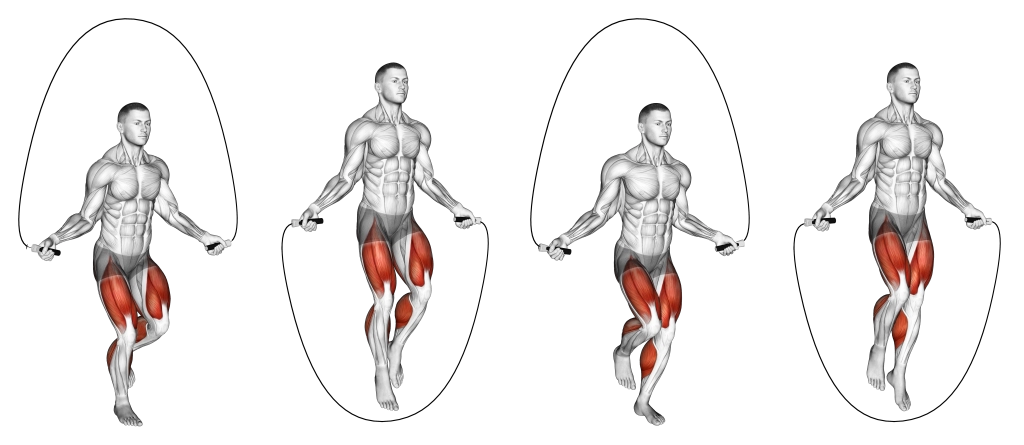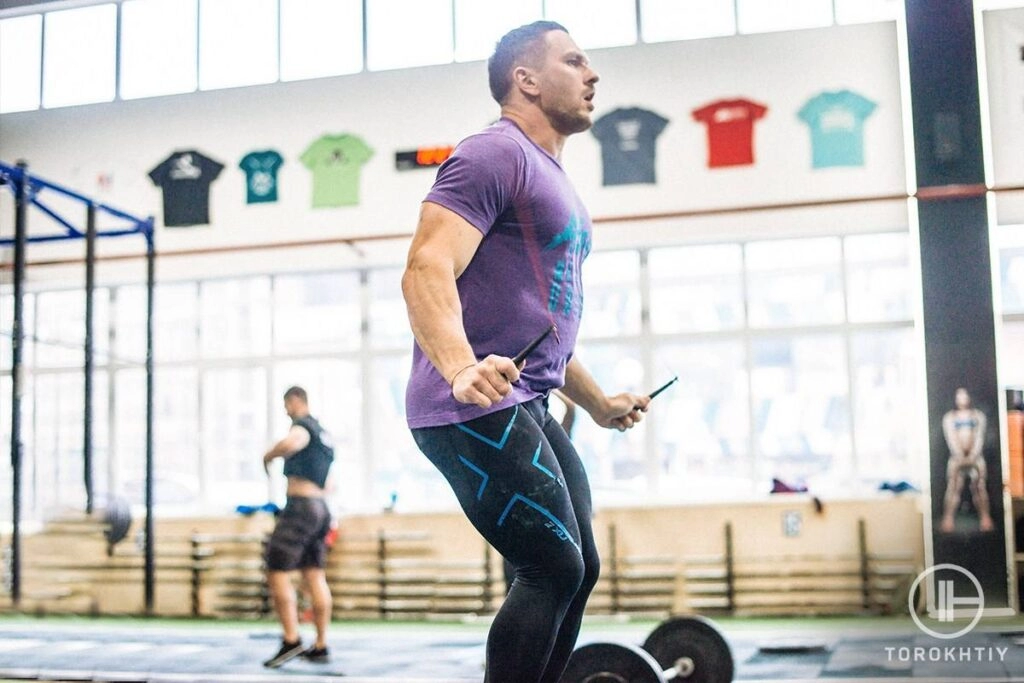What Are Jumping Jacks and Jump Rope
Definition of Jumping Jacks
Jumping jacks are a popular full-body aerobic workout that involves jumping while simultaneously moving your arms and legs. This exercise engages multiple muscle groups by requiring you to jump your feet out to the sides while raising your arms overhead, then returning to the starting position. Known as an effective cardiovascular workout at home, jumping jacks improve heart health, endurance, and coordination without needing any equipment.
Definition of Jump Rope
Jump rope is a rhythmic skipping exercise that uses a rope to create continuous jumps. It is widely recognized for boosting cardio fitness, improving coordination, and enhancing agility. Jumping rope requires timing and rhythm, making it an excellent cardio and coordination exercise. It is often part of training routines for athletes, boxers, and fitness enthusiasts looking for effective calorie burn and cardiovascular benefits.
History and Popularity
Jumping jacks date back to the early 20th century and have remained a staple in physical education and military training due to their simplicity and efficiency. Their enduring popularity is due to the ease of doing them anywhere and their suitability for all fitness levels.
Jump rope also has a rich history, originating centuries ago as a playground activity and evolving into a serious fitness tool. It gained widespread popularity as both a recreational and competitive sport. Today, jump rope is widely recommended as one of the best cardio exercises for weight loss and improving overall physical fitness.
Both exercises remain favorites because they provide effective aerobic workouts without requiring expensive equipment or gym access, making them accessible for home workout routines and busy lifestyles.
Calorie Burn Cardiovascular Benefits of Jumping Jacks vs Jump Rope

When it comes to calorie burn, both jumping jacks and jump rope are effective cardiovascular workouts at home that deliver solid results, but they differ slightly in intensity and efficiency.
Calorie Burn Comparison
- Jumping jacks burn about 8 to 10 calories per minute, depending on your weight and workout pace.
- Jump rope tends to burn more calories, averaging 10 to 15 calories per minute, since it’s a higher-intensity exercise that engages your entire body continuously.
The faster pace and rhythm of jump rope contribute to this higher calorie expenditure, making it one of the best cardio exercises for weight loss.
Cardiovascular Health Benefits
Both exercises boost your heart rate effectively, improving heart health and lung capacity. They strengthen your cardiovascular system by increasing endurance and stamina.
- Jumping jacks provide a steady, moderate cardio workout that’s easier to maintain for longer periods.
- Jump rope offers a more vigorous cardiovascular challenge, improving aerobic capacity quickly and supporting better coordination and rhythm.
Intensity Levels and Workout Scalability
- Jumping jacks are easily modified for different fitness levels. You can slow down for low-impact cardio or speed up for a higher-intensity burn.
- Jump rope intensity depends on your pace and jump style (single bounce, double unders, or alternate foot jumps). This allows for a wide range of workout intensities from beginner to pro.
Both workouts can be tailored to fit your fitness goals. For example, combining jumping jacks for longer warm-ups and jump rope for high-intensity intervals creates a balanced cardio routine.
If you’re interested in jump rope specifically, check out the variety of PVC jump ropes designed to support different skill levels and workout intensities.
Muscle Engagement and Full Body Workout Jumping Jacks vs Jump Rope
Both jumping jacks and jump rope workouts engage multiple muscle groups, making them effective full-body aerobic exercises.
Muscles Worked by Jumping Jacks
Jumping jacks target key muscles including:
- Legs: Quadriceps, hamstrings, and calves get a solid workout thanks to the jumping and leg spreading motion.
- Core: Your abs and lower back muscles work to stabilize your body throughout the movement.
- Shoulders: Raising your arms overhead works the deltoids and upper back muscles.
This combination helps improve muscle tone, endurance, and overall coordination, making jumping jacks a great choice for those wanting a balanced muscle engagement with simple moves.
Muscles Worked by Jump Rope
Jump rope focuses on different but equally important muscle groups:
- Calves: Repetitive jumping builds strength and endurance in the calves.
- Shoulders and Forearms: The continuous turning of the rope strengthens shoulder muscles and forearm grip.
- Core: Your abs and obliques stay engaged to maintain posture and balance during skipping.
Jump rope also excels at improving muscle endurance and muscular coordination, especially in the lower legs and upper body, contributing to better stamina and agility.
How Each Exercise Builds Muscle Tone and Endurance
- Jumping jacks offer more involvement of the upper body and legs together, promoting balanced muscle tone and cardiovascular endurance. They are great for people looking for a full-body workout without any equipment.
- Jump rope emphasizes lower leg strength and upper body coordination, which can boost endurance more quickly due to the rhythm and pace. It also helps develop quicker reflexes and better timing.
Both exercises improve muscle endurance with consistent practice, but if your goal is to hone coordination alongside muscle tone, jump rope has a slight edge. Meanwhile, jumping jacks are perfect for a full-body burn with less coordination needed.
both workouts complement each other well for a full-body, muscle-toning cardio session—important for any home cardiovascular workout routine aimed at fitness or weight loss.
Accessibility and Equipment Requirements for Jumping Jacks vs Jump Rope
When it comes to accessibility, jumping jacks are hard to beat. They require no equipment at all and can be done anywhere—whether you’re at home, in a hotel room, or even outside. This makes jumping jacks a top choice for a quick, convenient cardiovascular workout at home or on the go.
On the other hand, jump rope workouts need a jump rope, which means there’s a small equipment requirement. But this is a pretty minimal hurdle, especially if you invest in a good quality rope like the PVC jump ropes available at PVCJumpRope.com. PVC ropes are lightweight, durable, and ideal for all levels—from beginners who want an easy start to pros seeking performance.
Space and Coordination Considerations
Jumping jacks can fit in very tight spaces since you don’t need extra gear or much room to move. All you need is enough vertical space to jump safely.
Jump rope workouts do require a bit more space, especially above your head and around your feet to swing the rope freely. Also, jump rope demands some coordination and rhythm, which might be a small learning curve for some.
Portability and Convenience
Jumping jacks are ultra portable because you only rely on your own body. No packing necessary.
Jump ropes, especially PVC ropes, are also very portable—they can be folded or carried in a gym bag without hassle. The lightweight design of PVC ropes makes them a favorite for people who want to take their workout anywhere, from the gym to a park or travel.
- Jumping jacks require zero equipment and minimal space.
- Jump rope needs a rope (PVCJumpRope.com has quality options) and a bit more room but offers portability and performance.
- Ideal choice depends on your space availability, preference for equipment, and interest in improving coordination.
For more on choosing the right jump rope and how to get started, check out how to jump rope like a boxer and explore PVC jump rope options here.
Impact on Joints and Injury Considerations for Jumping Jacks vs Jump Rope

When choosing between jumping jacks and jump rope, it’s important to consider how each exercise affects your joints, especially the knees and ankles.
Joint Impact of Jumping Jacks
Jumping jacks involve repeated jumping with arms and legs moving away from the body, which creates moderate impact on knees and ankles. The landing can sometimes be hard, especially on unforgiving surfaces like concrete. This impact can cause discomfort or injury if you have pre-existing joint issues or poor landing mechanics. However, because the movement is relatively simple and low speed compared to jump rope, it’s often easier for beginners to control their form and minimize joint stress.
Joint Impact of Jump Rope
Jump rope is a high-impact cardio workout with rapid jumping and quick landings on the balls of your feet. This repetitive motion puts more stress on your ankles, knees, and even hips than jumping jacks do. The quick bounce-off and landing require both strength and coordination, which can increase the risk of injury if the surface is hard or the technique is poor.
What This Means for Beginners or Joint-Sensitive Individuals
- If you have sensitive knees or ankle issues, jumping jacks might be gentler since they allow for slower, more controlled landings.
- For those starting out, always perform either exercise on a shock-absorbing surface, like a gym mat, wooden floor, or gym turf to reduce joint strain.
- Beginners should start slow—focus on proper landing with knees slightly bent and feet softly touching the ground to minimize impact.
- If you have chronic joint pain, consulting with a healthcare provider before starting high-impact exercises like jump rope is wise.
Both jumping jacks and jump rope can be part of your cardiovascular workout at home, but modifying intensity and paying attention to technique can make all the difference in preventing joint injuries.
For more beginner jump rope tips and routines that consider joint health, you can check out this beginner jump rope workout routine that emphasizes form and gradual intensity build-up.
Skill and Coordination Jumping Jacks vs Jump Rope
When it comes to skill level, jumping jacks are straightforward and beginner-friendly. Almost anyone can start jumping jacks without prior experience. The movement is simple: jump while spreading your legs and raising your arms, then jump back to the starting position. This makes jumping jacks an easy cardiovascular workout at home for all ages and fitness levels.
Jump rope, on the other hand, demands more coordination and rhythm. You’re timing your jumps with the rope swings, which means you have to develop a sense of rhythm and good timing. The jump rope benefits for fitness go beyond just cardio—it improves your agility, footwork, and overall coordination. Many beginners trip up on the rope at first, so developing this skill takes practice but pays off with better movement control.
Benefits of Jump Rope for Coordination Rhythm and Agility
- Improves hand-eye coordination: You’re syncing rope rotation with jumping intervals.
- Enhances rhythm and timing: Keeps your body moving smoothly, beneficial for all fitness activities.
- Boosts agility and quick footwork: Great for sports training and overall mobility.
- Increases concentration and focus: Staying in rhythm with the rope requires mental sharpness, raising workout quality.
In contrast, jumping jacks focus more on endurance and general body movement but don’t offer the same coordination challenge. For those wanting to sharpen their motor skills and rhythm, adding jump rope to your routine is a smart choice.
Whether you’re a beginner or looking to improve your cardiovascular workout, remember that jumping jacks are easier to start, but jump rope delivers superior coordination and agility benefits as your skill progresses.
Which One Should You Choose Jumping Jacks vs Jump Rope for Cardio Workouts
When weighing jumping jacks vs jump rope, it really boils down to your fitness goals, available space, and skill level. Here’s a quick breakdown of each:
Jumping Jacks Pros and Cons
Pros:
- No equipment needed, easy to do anywhere
- Great full-body workout targeting legs, core, and shoulders
- Low barrier to entry, simple to learn
- Good for quick warm-ups or home cardio workouts
Cons:
- Can be less intense compared to jump rope
- Might be higher impact depending on surface
Jump Rope Pros and Cons
Pros:
- Burns more calories per minute on average
- Excellent for improving coordination, rhythm, and agility
- Portable and scalable with different rope types, like PVC jump ropes from PVCJumpRope.com
- Targets calves, shoulders, forearms, and core
Cons:
- Requires a jump rope and enough space to use it safely
- Takes some skill and practice to do effectively without tripping
- Can be tougher on joints for beginners
How to Choose Based on Your Needs
- If you want a simple, no-fuss workout that fits anywhere, jump jacks are ideal.
- If you’re aiming for a higher calorie burn and want to boost coordination, jump rope wins.
- Space constraints and your level of experience also matter—jump rope demands some room and rhythm.
The Best Approach Combining Both
To get the most out of your cardio routine, combine jumping jacks and jump rope. This mix:
- Keeps your workouts fresh and less repetitive
- Covers a wider range of muscle groups and movement skills
- Balances low and higher-impact cardio training
Adding both exercises allows you to tailor your sessions whether you’re working out at home or on the go, addressing endurance, coordination, and full-body conditioning efficiently.
How to Get Started with Jump Rope Tips and Product Recommendations
If you’re ready to add jump rope benefits for fitness to your routine, starting with the right gear makes all the difference. PVCJumpRope.com offers high-quality PVC jump ropes designed for everyone—from beginners just learning their rhythm, to pros pushing serious cardio workouts. These ropes are lightweight, durable, and perfect for indoor or outdoor cardiovascular workouts at home.
Choosing the Right Jump Rope
Picking the right rope helps you improve quicker and avoid frustration. Here’s what to keep in mind:
- Length: Stand on the middle of the rope, handles should reach up to your armpits. This length fits most skill levels.
- Weight: Lightweight ropes are great for speed and endurance, heavier ones build strength and timing.
- Material: PVC ropes, like those from PVCJumpRope.com, are smooth and fast, ideal for a variety of workouts.
- Handles: Look for comfortable, non-slip grips to prevent hand fatigue during longer sessions.
Simple Jump Rope Workouts for Every Level
Start easy and build your way up with these sample routines:
-
Beginner:
- Jump for 30 seconds
- Rest for 30 seconds
- Repeat 5 times
Focus on maintaining a steady rhythm and landing softly.
-
Intermediate:
- Jump for 45 seconds
- Rest for 15 seconds
- Repeat 8 times
Add variations like single-leg jumps or side-to-side hops.
-
Advanced:
- Jump for 1 minute
- Rest for 15 seconds
- Repeat 10-12 times
Include double-unders, high knees, or crisscross moves to boost coordination and calorie burn.
Using a reliable PVC jump rope lets you smoothly progress through these routines while boosting your cardio and coordination. Plus, the portability of ropes from PVCJumpRope.com means you can easily squeeze in your workout anywhere—no gym needed.



